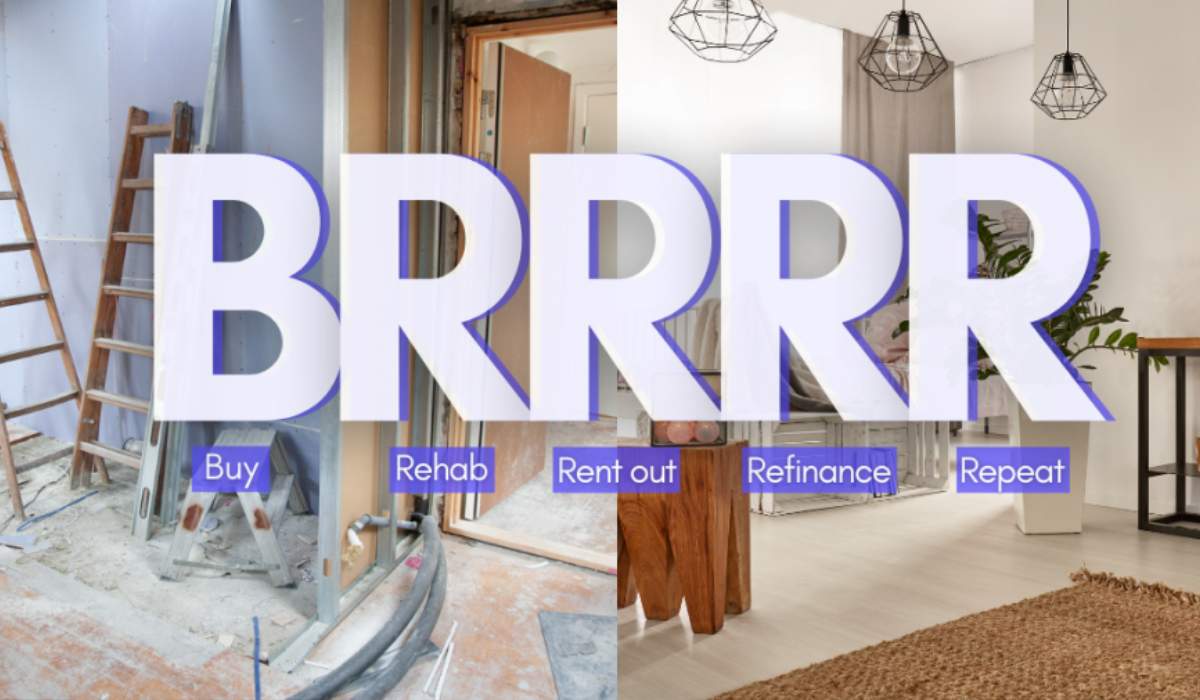Cracking the Code: Demystifying the BRRRR Method in Real Estate Investment.
A successful real estate investment strategy known as the BRRRR (Buy, Rehab, Rent, Refinance, Repeat) Method entails buying distressed properties, renovating them, renting them out, and finally refinancing to fund additional investments. The BRRRR Method, in contrast to conventional investment approaches, depends on buying properties that require renovation and using refinancing to increase one’s portfolio.
Understanding the BR Method’s complexities, including its inner workings, benefits, and potential downsides, is crucial if you’re a real estate investor looking to investigate this dynamic technique. You can determine if this strategy fits with your financial objectives and real estate investment dreams by investigating its mechanics. Learn the fundamentals of the BRRRR Method and obtain insightful knowledge to successfully navigate the real estate investment world.
The BRRRR Method: A Step-by-Step Guide

Real estate investing has been transformed by the BRRRR Method (Buy, Rehab, Rent, Refinance, Repeat), which provides a methodical way to create passive income and amass a portfolio of rental properties. Investors can unleash this strategy’s potential to establish a never-ending cycle of property acquisition and ownership by grasping its fundamental dynamics. The BRRRR Method operates as follows.
acquire a property The BRRRR Method is based on buying distressed properties that are priced lower because of their state. There is a chance to save a lot of money on this initial purchase.
Renovate the building: After the property is purchased, rehabilitation becomes the main priority. The property undergoes extensive renovations to improve its structural soundness, safety, and visual appeal, making it rent-ready and appealing to potential renters.
Lease out the space: It’s time to find renters and start earning rental revenue now that the property has been completely renovated. To guarantee a consistent revenue flow, it is essential to choose the right rental rate and market the property well.
Refinance the property with cash out: A cash-out refinance is carried out using the increased equity in the property as leverage. By taking out a higher mortgage and spending the extra money on other things, like buying more properties, this tactical move enables investors to access the built-up equity.
Purchase a different property with money from the refinance: Investors might continue the cycle by buying another foreclosed property with the money they received from the refinancing procedure. Then, after being repaired, rented out, and refinanced, the property generates a steady supply of investment opportunities.
Investors can use the BRRRR Method to grow their real estate portfolio, increase their returns, and create a reliable passive income stream by carefully following these procedures.
Key Advice for Each Stage of the BRRRR Method Journey

The BRRRR Method (Buy, Rehab, Rent, Refinance, Repeat) is a potent real estate investing method, but success depends on each stage being carried out precisely. Here are some helpful hints to help you navigate each stage of the procedure.
Buy: Traditional finance may be difficult to obtain when buying a distressed home due to valuation issues and the state of the property. Examine alternate choices including hard money loans or home equity lines of credit (HELOCs), but be mindful of the hazards involved. By contrasting the proposed upgrades to the property with recently sold comparable properties, you may determine the after-repair value (ARV). Observe the 70% rule, meaning that you shouldn’t pay more than 70% of the property’s ARV.
Rehab: Set priorities for essential upkeep in order to meet construction regulations and guarantee livability. Put your attention on upgrades that will increase the value of your home, such as remodeling the kitchen and bathroom, improving the curb appeal, and adding energy-saving features. For the rehabilitation project to be managed successfully, establish a realistic budget and timeframe.
Before requesting a refinance, find renters because lenders often want an occupied property in order to do so. Choose tenants who have a history of timely payments, dependable references, steady jobs, and good credit reports. Follow all housing regulations and conduct complete tenant screenings, including credit and background checks. Subtract the entire expenses from the monthly rent to arrive at a fair rental price that produces a positive cash flow.
Refinance: Use the cash from your investment property’s refinance to buy a different distressed property. Locate a lender that offers cash-out refinancing and satisfies their requirements, which may include a minimum credit score, a maximum debt-to-income ratio, and home equity. Get ready for the refinancing procedure’s additional costs and an appraisal.
Repeat: The last stage is to repeat the entire BRRRR Method by starting a fresh cycle of buying, fixing up, renting, and refinancing properties. Keep thorough records and draw lessons from the past to improve future results.
You may maximize the benefits of this approach and create a profitable real estate investment portfolio by paying close attention to these pointers and remaining disciplined during each stage of the BRRRR Method.
Investigating the BRRRR Method: Weighing the Benefits and Drawbacks

A detailed analysis of the benefits and drawbacks of the BRRRR (Buy, Rehab, Rent, Refinance, Repeat) Method is necessary before choosing it as your real estate investment strategy to make sure it fits with your objectives and preferences. The benefits and drawbacks of this strategy are broken down as follows.
Pros:
Stream of Income: You can use rental properties to make passive income using the BRRRR Method. You can have a consistent flow of rental income by buying distressed houses, fixing them up, and renting them out.
Portfolio Expansion: Using this tactic, you can gradually grow your rental portfolio. Each property you buy and rent out as you go through the BRRRR process adds to the expansion of your investment portfolio.
Equity Building: Using the BRRRR Method’s rehab stage, you can raise the property’s value. You can generate equity and even raise the market value of the home by strategically making modifications and enhancements.
Cons:
Work and Costs: A distressed property may require expensive and time-consuming rehabilitation. The property needs to be brought up to code and made rental-ready, which costs money and takes work.
Financial Difficulties: For distressed houses, it may be difficult to get a traditional mortgage, necessitating the use of more expensive or risky financing options. Your overall profitability and borrowing expenses may be impacted by this.
Uncertain Refinancing Results: You run the risk of qualifying for less money than you had anticipated when it comes time to refinance. This can affect your capacity to finance your next real estate purchases.
<div id=viewer-hn8 class=xVISr Y9Dpf bCMSCT OZy-3 lnyWN yMZv8w bCMSCT public-DraftStyl